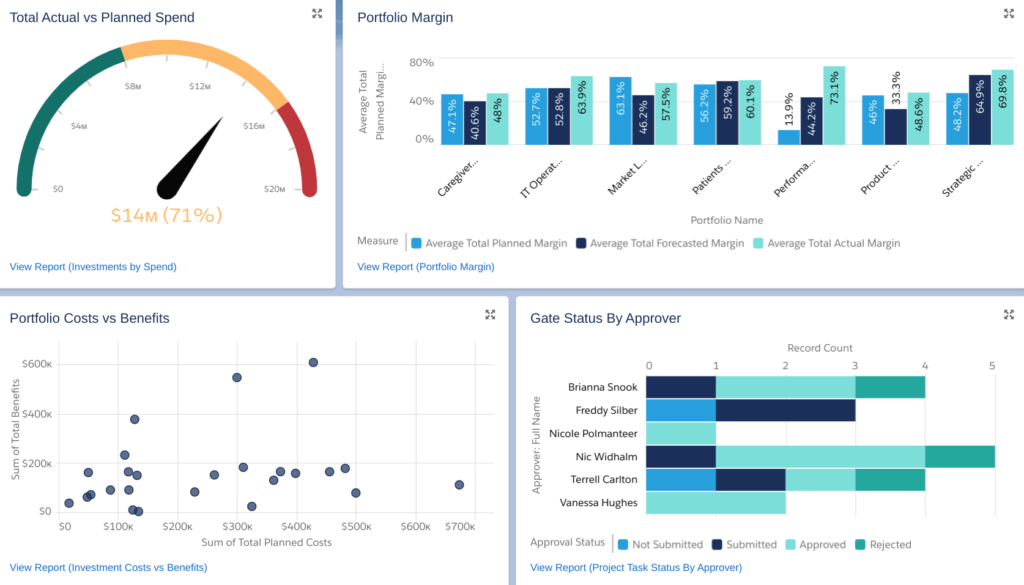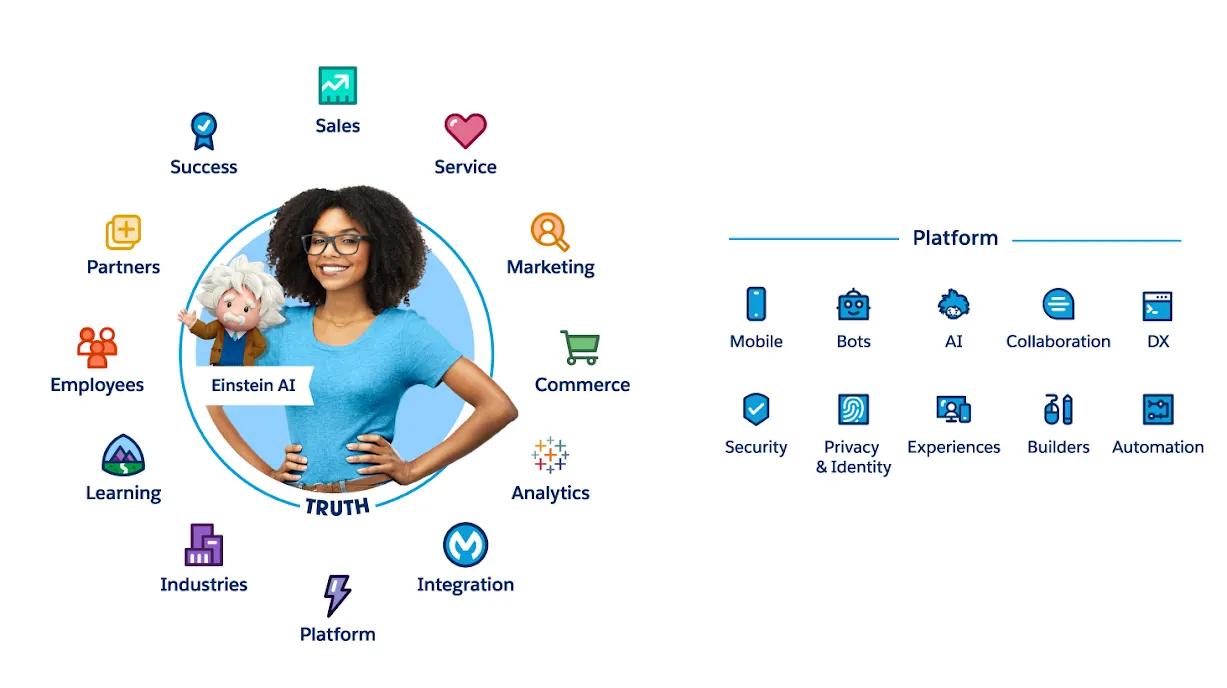Top 5 Reasons to Run Your PPM on Salesforce


This interactive eBook explains the top five reasons why organizations like yours already choose to run their projects, processes and workflows on the Salesforce platform. Read on to find out more.
Brought to you by
CHAPTER 1
ROI
1. ROI
For any PMO, showing a return on investment from the projects that you choose to run is key to your success. By leveraging a PPM solution built on Salesforce you can:
- Capture demand from the business
- Group demand into business areas and portfolios
- Estimate potential costs for each project
- Estimate potential financial benefits for each project
- Estimate any qualitative non financial KPIs that will be met for each project (e.g. meetings government mandated standards, training individuals, CSAT and much more)
- Estimate any potential risks such as unfamiliar technology platforms
Use the information above in conjunction with Salesforce reporting engine to establish which projects come with the highest ROI and least risk for your business.
This product has helped us scale our services and develop our staff. We can easily see project status at a glance, profit margin, cash and revenue forecasting, expense management, rate cards for clients and projects, resource planning, and client KPIs.
Tim Lockie, CEO, Now IT Matters
Real-time reporting
With all the AppExchange apps come pre built dashboard reporting that you can also tailor to your own needs. Even better, all reports are available in real time, on any device, at any time of the day, and can even be automated to appear automatically in your executive teams inbox.
Whether viewing dashboard charts for quick updates, or drilling into reports for critical KPIs, managing your projects on Salesforce means project data is available at all times meaning you can report on every detail along the way.
All your PPM data is captured at key moments and available for reporting within seconds. Never miss a moment or a milestone, and get visualization into everything happening on your portfolio, program or project, no matter the time of day or the device you’re using. As discussed earlier, you can even share these reports with your external stakeholders.
Visualise KPIs
Whether you’re viewing demand or portfolios, using a Salesforce-native app to run your projects means you can truly take control of your benchmarks and KPIs, allowing you to monitor the data that matters most to you.
You can even create, control, and switch between multiple dashboards tailored to your business so you can view your KPIs and project metrics in real time.
CHAPTER 2
Resource Management
2. Resource Management

Managing portfolio, programs and projects invariably involves managing lots of moving parts. And, with people costs invariably forming a large proportion of your costs, finding the right resources with availability at the right time is one of the trickiest, and most important, aspects to master.
For any project or planned project, it is essential to have a clear understanding of what employees are suited to the task at hand, what level of expertise in the skill each employee has, and ultimately are they available when they are needed?
Optimizing your PPM through resource management on Salesforce allows your organization to always prioritize high value work with your current availability of resources.
A Salesforce-native solution can help you deliver the functionality needed to plan and execute your projects. With a tool that is capable of capacity and demand management, resource utilization, and can track both time and progress, you can improve resource efficiency and utilization. Ultimately benefiting your business’ bottom line
Assign your team to projects based on skills and availability
Project execution involves a vast array of team members, carrying out a range of specialized tasks at different times throughout the project.
Making sure you manage your processes as effectively as possible is going to be key to trust, satisfaction and, ultimately, project success. If you’re managing multiple projects and business units, the process of assigning team members to a project can be a daunting administrative task… But it doesn’t need to be.
CHAPTER 3
Process Improvement
3. Process Improvement
By giving your team a way to access crucial data (on anything from needs, history, interests and even their frustrations), your team can serve experiences tailored that meet the needs of your customers. You can see what is working, and why. And, by templatizing the approaches that work, your best practices can be followed every time.
Templating and automating repeatable processes means you’ll be able to follow your organization’s best practices, while also saving time during project creation and set up.
Approvals
If you’re spending millions of dollars on a project, it’s vitally important that processes are followed correctly – and that means getting approval from the right stakeholders at the right stages of your project. By running your PPM on Salesforce, you can ensure that your approvals processes meet the rigorous standards your projects demand, even if multiple approvals are required. You can set approval routing based on certain criteria, and even enable alerts letting you know when something has been approved or rejected.
Stage gates

The approval processes in Salesforce can be used to approve or reject at stage gate checkpoints. The logic behind unlocking records when a gate is passed can be complex though, and making a custom-build integration with Salesforce is likely to be difficult and costly. Some apps, like Cloud Coach, have stage gate functionality built into their solutions. You should be looking for a Salesforce solution that allows you to define your gate process along with what information is required to pass each gate. With the right Salesforce solution, you can:
- Prioritize high ROI projects over low ROI projects leading to better overall fiscal performance for your business
- Minimize wasted spend and effort for you team
- Re-work initiatives to extract repeatable value
Automation
Your PPM processes can also be improved by automating aspects of your project. We explain more on automation in the Time Savings chapter next!
CHAPTER 4
Time Savings
4. Time Savings
Although no two customers – or projects – are the same, processes are largely repeatable. In fact, repeatable processes make up over 70% of every companies workload. So how can you help your organization be more efficient and save time?

Templating
There are some great PPM apps pre built and available on the AppExchange to get you started. Most of these support the notion of project templates, which allow you to build out repeatable lists of your important tasks. So when you create a new project your team instantly knows what tasks need to be done and by when. More advanced solutions such as Cloud Coach allow you to template much more than just project tasks, so you can follow best practices and speed up delivery across all areas of your project including requirements, goals, documents, financials and more.
Automating
Now you’ve templated your best practices, why not take that performance increase to the next level by automating your processes? You can automate items across your projects including demand intake and requests, approvals processes, or even project priority rankings. The options are almost endless, and best of all the automation is the same automation your team already uses for Salesforce so there is no need for your admins to learn a second system, you just leverage the existing skills they already have.
Even meetings can be templatized, allowing you to set what should be discussed, so you never miss an agenda item again!
Real-time KPI reporting and dashboards

Collecting data is one thing, but presenting it to your management team in a manner that lets them make informed decisions to improve the business is another. In a busy work day, accessing that information needs to be easy, sharing it needs to be simple, and it should be presented in an easily digestible, relevant format.
That’s why your Salesforce PPM solution should come with a set of out of the box reports while also allowing further customization, so all the reports and dashboards that your executives need to make decisions to drive your business forward are always at hand. By running your PPM on Salesforce you can report on all your KPIs in real time, 24 hours a day from any device, and easily share with relevant executives – to same even more time, these emails can be automated to send at a regular cadence of your choosing!
CHAPTER 5
Customer 360
5. Customer 360
What is a customer 360?
With a single, shared view of your customers, your teams can better meet your customer demands.
Salesforce defines Customer 360 as a way to ‘give everyone in your company a single, shared view of your customers’. This means that all of your teams, from marketing and sales, through to commerce, service and IT departments, can all work as one – allowing you to deliver personalized experiences that customers love, and giving you the foundations to build lasting, trusted relationships.
Linking Sales and Service Clouds
Projects form a vital component of your Customer 360. Onboarding projects complete the crucial link between Sales and Service, while ongoing Customer Success initiatives and projects are a great way to keep to build and improve customer relationships on Salesforce. But only if you’re using the correct systems.
When managing customer relationships, the best solutions connect your entire business around the customer, from sales, service, and marketing to IT, and analytics. For the best customer experiences, it’s vital you’re using the same system for both sales, onboarding and service.
Salesforce means you can easily log, manage, and analyze all customer activity in one place. The Salesforce platform provides an ecosystem of fully connected mobile and social tools all powered by the cloud, with Customer 360 at the heart. With Sales Cloud and Service Cloud working in tandem on the same platform, your business can keep up with the speed, innovation, and connectivity that produces great customer experiences leading to customer loyalty. By connecting all of your data, you can build 360-degree views of each customer and provide seamless interactions across any channel or department.
By using one of the Salesforce native PPM tools from the AppExchange you can seamlessly connect onboarding projects to all your favorite Salesforce records such as accounts, opportunities or cases, so customer data flows freely giving you that true 360 Customer view. Deals can be closed from the Sales Cloud, Customers can be onboarded using a Salesforce-native app like Cloud Coach, and ongoing support can be provided from the Service Cloud. The whole customer journey with you, managed without leaving Salesforce.
Create tailored, relevant customer experiences
Although processes are largely repeatable, no two customers are the same. By giving your team a way to access crucial customer data (on anything from needs, history, interests and even their frustrations), your team can serve experiences tailored that meet the needs of your customers. It sounds so simple, doesn’t it? By working within the Salesforce platform, account managers will always have access to up-to-date information before in advance of any customer or client call under the account record, be it project timelines, change requests, billing information and more.
CHAPTER 6
Conclusion
What Next?
So, you’ve taken a look at how using Salesforce for project portfolio management could be the right step for your organization. The next question you need to explore is: how do I make that happen?
By leveraging the expertise of your consulting partners, or even your internal Salesforce experts, you may have the capabilities to build a basic PPM on Salesforce in house if your needs are simple and unlikely to change. Or you might considering buying an AppExchange solution instead. Before making any decision though, there are a number of factors you should consider. Cost, control, maintenance and risk will all need to be carefully evaluated.There’s a great Buy or Build guide available at Projects on Salesforce to help you decide what makes the most sense for your organization.
You might also be interested in…
8 Capabilities Your PPM Solution Should Have
What should you consider when choosing a solution for PPM? Our eBook explains what features you should look out for.
























